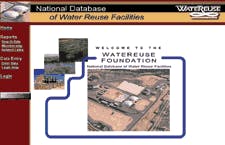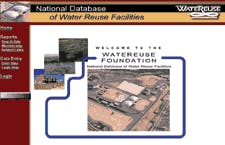As America’s water supplies have become progressively taxed by ever increasing demand, the need to develop safe, reliable alternative water resources is becoming increasingly apparent. Because the nation’s wastewater discharge is continuous (regardless of precipitation conditions) and relatively well-controlled, the recycled water derived from it represents one of the most reliable water supplies available.
The practice of using recycled water for non-potable applications reduces demands on other resources, encourages a higher level of control over the fate of pollutants, and minimizes discharges to fresh water sources. In addition to the effluent from wastewater treatment and water reclamation plants that treat sanitary sewage, there is an increasing trend to develop poor quality groundwater, industrial brine and process concentrates, and stormwater discharges into reliable alternative supplies.
While the growth of water reuse is ongoing, the expansion has been fragmented due to the lack of a comprehensive source of statistics and information about reuse programs and facilities. Although extensive knowledge exists, it has not been captured in a single, widely available tool, making it difficult for utilities to learn from one another and share solutions. Without a comprehensive reservoir of reuse facility data, regulators, utilities, water resource planners, design engineers, equipment suppliers, and others involved in water reclamation projects have been forced to rely largely on personal or anecdotal experience, market research, and other disjointed or indirect sources of information.
With the goal of improving the dissemination of information regarding the practice of water reuse to promote reuse in order to foster more efficient and economical water reclamation planning, as well as to prevent the dissemination of misinformation, the WateReuse Foundation (WRF) developed a comprehensive database of nationwide reuse programs and facilities. The database is intended to be used by agencies, utilities, consultants, and consumers to advance the practice and implementation of water reuse at the local, regional, state, and national levels.
The database, created for the WRF by Malcolm Pirnie Inc. and HDR Engineering, stores critical elements defining the practice of water reuse as it exists in the nation. It consolidates information on a variety of reuse topics, including statistics on reuse usage and costs on a state-by-state basis, public relations and community outreach tactics, and innovative solutions to many reuse challenges experienced by utilities.
The database includes 73 information fields, including:
- Water Reuse Utility contact information that allows ease of contact.
- Water Reuse Utility program management information on subjects such as cross-connection control and public education programs.
- Water Reuse Utility-identified benefits and challenges to implementing a water reuse program.
- Information by utility and facility on the production statistics and treatment technologies employed and information on water reuse distribution system characteristics.
- Water Reuse Utility identified end use of the water as well as utility rate information. Types of end uses include irrigation, recharge, industrial processes, commercial process and natural system restoration.
To date, 17 states have provided water reuse utility contact information, with more than 1,250 water reuse utility contacts in the database. The bulk of reuse facility contacts are in four states: Florida, California, Texas and Arizona. Four hundred and eighty water reuse utilities have entered data on their facilities, with total treatment capacity exceeding 3.1 million gallons per day (MGD), producing 410 billion gallons per year of reused water.
Some notable findings include:
1. The majority of reclaimed water is used as follows:
- a. Nationwide − Irrigation (88%) followed by industrial use (11%), recharge and wetlands.
- b. Arizona − Irrigation followed by recharge and then industrial use.
- c. California − Irrigation followed by industrial and then recharge.
- d. Florida − Irrigation followed by recharge and then industrial and then wetlands.
- e. Texas − Irrigation followed by industrial and recharge.
The power of the WRF National Database for Water Reuse Facilities is that it is online and therefore utilities have instant and constant access to the Survey Module in order to edit the data for their utility. As a result, the query output will be different from time period to time period depending on how the Survey Module has been edited by individual water reuse utilities.
To register for access to the database, contact the WRF at www.watereuse.org.





